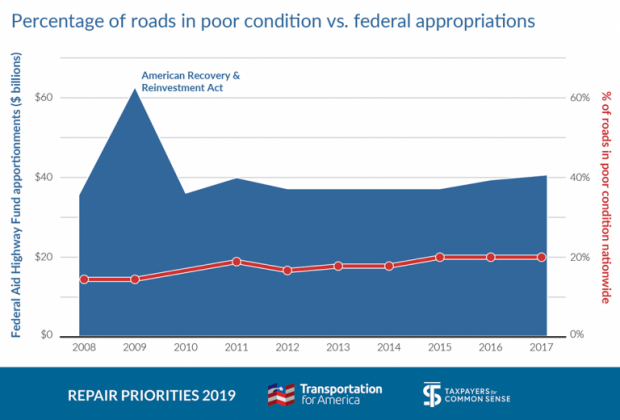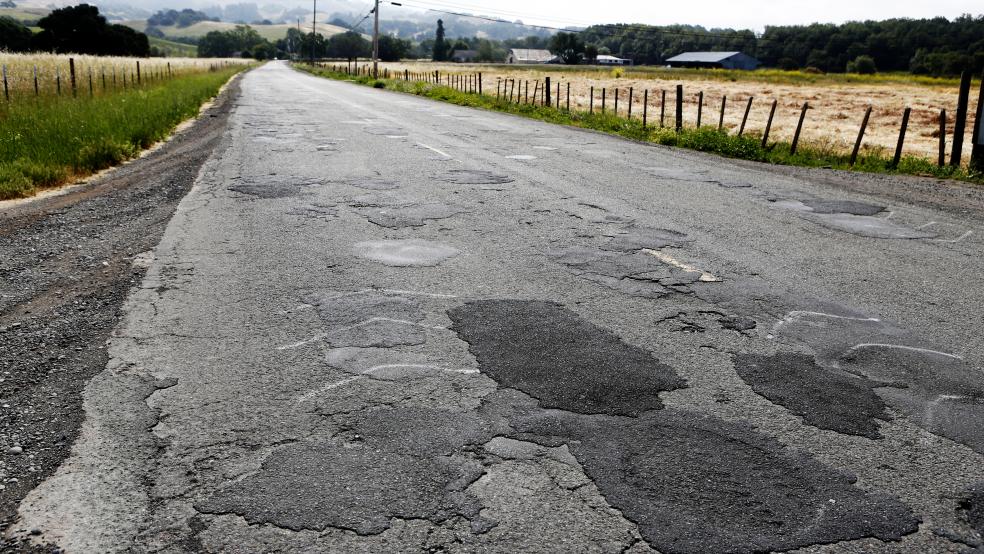It’s Infrastructure Week again in Washington, but as President Trump and lawmakers continue to discuss a potential package of up to $2 trillion, a new report warns that a one-time infrastructure spending spree isn’t what’s needed to properly address the nation’s road conditions. “This is more than a money problem—it’s a priorities problem,” the authors say.
The report, “Repair Priorities 2019,” was published this week by the groups Transportation for America and Taxpayers for Common Sense. It found that, despite more spending, the percentage of U.S. roads in “poor condition” grew from 14% to 20% from 2009 to 2017. Thirty-seven states saw the percentage of their roads in poor condition increase over that time.

The underlying problem, according to the report, is that states, given flexibility in how they spend transportation infrastructure funds, are shortchanging basic repair and instead choosing to expand their road networks. States spent an average of $21.3 billion a year on road expansion between 2009 and 2014, compared with $21.4 billion on road repair.
And the new roads being built create future maintenance liabilities, adding to the funding shortfall. Every new lane-mile of road costs about $24,000 a year to maintain in good repair, according to the report. “By expanding roads, we are borrowing against the future,” the report says, adding that we now have to spend an additional $5 billion a year to keep new roads built from 2009 to 2017 in good condition.
That’s not to say that money isn’t an issue. The report estimates that it would cost more than $231 billion a year over six years (the typical length of a federal transportation reauthorization) to keep existing roads in good condition and fix the roads in poor condition. That is more than double the $105.4 billion spent across all levels of government on highway capital expenditures in 2015, only a portion of which went toward repairs.
But talk of a $2 trillion infrastructure plan — which, to be clear, Democrats want to have cover much more than just roads? “We don’t need it, and it could even do more harm than good,” Beth Osborne, director of Transportation for America, writes in a new Washington Post op-ed. “At best, this infrastructure plan would throw more money into the same flawed system. At worst, Congress and the president would be signing a blank check with no sense of what the money is intended to accomplish, no clear system for accountability, no requirements for states to actually repair our ‘crumbling roads and bridges’ and no guarantees that any of us would have an easier time getting from A to B when all that money has been spent.”
The report lays out a number of recommendations for a 2020 transportation bill, including:
- Set clear, quantifiable and measurable outcomes that new funding is expected to accomplish.
- Require that states repair their existing roads before expanding.
- Require project sponsors to show that they can afford to maintain new road projects.
- Establish reporting requirements to allow progress to be tracked and published.
“What do all these ideas have in common?” Transportation for America asks on its site. “They’re about policy not money.”




